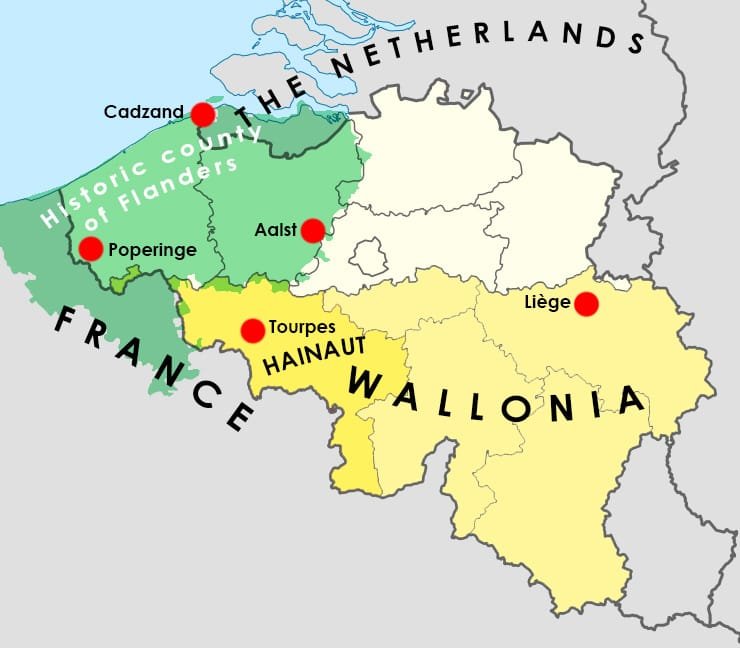Wallonia
Wallonia, the French-speaking region of Belgium, is often overshadowed by its more famous counterpart, Flanders, when it comes to beer culture. However, this region boasts a rich history of brewing that is deeply intertwined with its agricultural practices, local ingredients, and cultural heritage. The traditional beer styles of Wallonia are not just beverages; they are reflections of the land, the people, and the history that shaped them. In this article, we will delve into the unique beer styles of Wallonia, exploring their origins, characteristics, and the stories behind them.
The Historical Context of Wallonian Brewing
To understand the traditional beer styles of Wallonia, one must first appreciate the historical context in which they developed. The region’s brewing tradition dates back centuries, influenced by various factors such as geography, climate, and local customs. Wallonia’s fertile soil and temperate climate made it an ideal location for agriculture, particularly barley and hops, the two primary ingredients in beer.
During the Middle Ages, monasteries played a crucial role in the development of brewing in Wallonia. Monks not only brewed beer for their own consumption but also for sale, which helped fund their religious activities. This practice laid the groundwork for many of the traditional beer styles we recognize today.
Key Traditional Beer Styles of Wallonia
1. Saison

Saison is perhaps the most iconic beer style to emerge from Wallonia. Originating in the Walloon region, this farmhouse ale was traditionally brewed in the winter months and consumed during the summer by farm workers. The word “saison” translates to “season” in French, reflecting its seasonal brewing practices.
Saisons are characterized by their fruity and spicy flavors, often derived from the use of unique yeast strains and a variety of grains. The beer is typically pale to amber in color and has a moderate to high carbonation level. The flavor profile can range from citrusy and floral to earthy and herbal, making it a versatile choice for pairing with food.
One of the most notable aspects of saisons is their adaptability. Brewers often experiment with different ingredients, leading to a wide range of interpretations of this classic style. This creativity has contributed to the resurgence of saison in craft breweries around the world.
2. Bières de Garde
Bières de Garde, which translates to “beer for keeping,” is another traditional style that hails from Wallonia. This style originated in the Nord-Pas-de-Calais region of France but has strong ties to Wallonia due to the proximity of the two regions. Historically, these beers were brewed in the winter and stored to be consumed later in the year.
Bières de Garde are typically strong, malty ales with a rich, amber color. They often exhibit flavors of caramel, toffee, and dark fruits, with a slightly sweet finish. The use of traditional ingredients and brewing methods gives these beers a unique character that reflects the terroir of the region.
While Bières de Garde may not be as widely recognized as other Belgian styles, they are cherished by those who appreciate their complexity and depth.
3. Trappist Ales
Wallonia is home to several Trappist breweries, which are known for their high-quality, traditional ales. Trappist beers are brewed within the walls of a Trappist monastery under the supervision of the monks, adhering to strict guidelines that emphasize quality and authenticity.
The most famous Trappist brewery in Wallonia is Chimay, which produces a range of beers, including Chimay Red, Chimay Blue, and Chimay White. Each of these beers has its own distinct flavor profile, with Chimay Blue being a rich, dark ale with notes of dark fruit and caramel, while Chimay White is a lighter, more refreshing option.
Trappist ales are typically bottle-conditioned, meaning they undergo a secondary fermentation in the bottle, which contributes to their complexity and carbonation. The spiritual connection to the brewing process adds an additional layer of significance to these beers, making them a symbol of the region’s brewing heritage.
4. Lambic and Gueuze
While Lambic and Gueuze are more commonly associated with the Brussels region, their influence extends into Wallonia. These spontaneously fermented beers are made using wild yeast and bacteria, resulting in a unique flavor profile that is often tart and funky.
Lambic is typically unfiltered and can be aged for several years, allowing it to develop complex flavors. Gueuze, on the other hand, is a blend of young and old Lambics, resulting in a sparkling, effervescent beer with a balanced tartness.
The production of Lambic and Gueuze is a labor-intensive process that requires a deep understanding of fermentation and aging. While not exclusive to Wallonia, these styles are an integral part of the broader Belgian beer culture and are celebrated for their distinctive characteristics.
The Role of Local Ingredients
One of the defining features of Wallonian beer styles is the emphasis on local ingredients. Many brewers in the region prioritize using locally sourced barley, hops, and even fruits to create their beers. This commitment to local agriculture not only supports the community but also enhances the flavor and authenticity of the final product.
For example, some breweries incorporate regional fruits such as cherries or raspberries into their beers, creating unique fruit-infused variations that reflect the terroir of Wallonia. This practice not only showcases the diversity of the region’s agricultural offerings but also allows brewers to experiment and innovate within traditional styles.
The Cultural Significance of Wallonian Beer
The traditional beer styles of Wallonia are more than just beverages; they are a reflection of the region’s cultural identity. Beer has long been a central part of social gatherings, celebrations, and rituals in Wallonia. From family gatherings to community festivals, beer is often at the heart of these events, fostering connections and creating shared experiences.
Moreover, the brewing tradition in Wallonia is a source of pride for many locals. The craftsmanship and dedication that go into producing these beers are celebrated, and many breweries offer tours and tastings to share their stories with visitors. This commitment to transparency and education helps to cultivate a deeper appreciation for the art of brewing.
Beer Styles of Wallonia
The traditional beer styles of Wallonia represent a rich tapestry of history, culture, and craftsmanship. From the refreshing and complex flavors of saisons to the deep, rich profiles of Trappist ales, each style tells a story that is deeply rooted in the land and its people. As the craft beer movement continues to grow, Wallonian brewers remain committed to preserving their heritage while also embracing innovation.
For those seeking to explore the world of beer, Wallonia offers a unique and rewarding experience. Whether you are sipping a crisp saison on a sunny terrace or savoring a rich Trappist ale in a cozy tavern, the traditional beers of Wallonia invite you to connect with the region’s history and culture in every sip.

